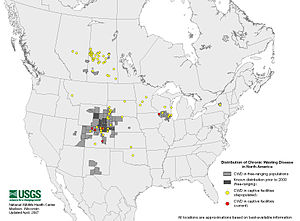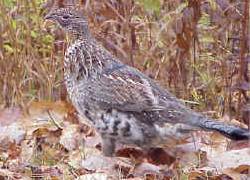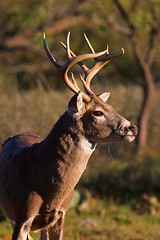 Image via Wikipedia
Image via WikipediaKansas City Mo - Missouri residents who hunt in other states should be aware of a new regulation regarding chronic wasting disease, which sets rules for transporting harvested antlered game into the state.
Archery deer season began Wednesday (Sept. 15) in Missouri and similar archery or blackpowder rifle seasons are underway or will soon start in neighboring states. Regular firearms seasons will follow later in autumn and winter.
The Missouri Department of Conservation (MDC) now requires that any hunter who brings a deer, elk or moose into the state with the head or spinal column attached to report the carcasses’ entry by calling 1-877-853-5665 within 24 hours of entering the state. If the head or spinal cord is intact on the animal, the hunter cannot process the meat or the trophy mount. Instead, they must take the carcass to a licensed meat processor or taxidermist within 72 hours of entry. Meat processors and taxidermists are required to dispose of the spinal cord and other parts in a properly permitted landfill.
Hunters do not need to report if they simply bring back meat, hides, antlers, teeth, skulls or skull plates with no brain tissue attached.
Chronic wasting disease is fatal neurological disease that affects cervids -- deer, elk and moose. There is no evidence that the disease can be transmitted to humans or livestock. What causes CWD and how it is transmitted is inconclusive. But the disease affects brain and spinal tissue, and there is concern that it could be passed into Missouri’s deer herd by bringing infected tissues into the state.
Missouri’s first confirmed case of CWD was a single whitetail deer identified in February in Linn County. That animal was in a fenced enclosure for deer and elk on a hunting ranch in Linn County in north central Missouri. Biologists tested other cervids within the enclosure and free-ranging deer killed in adjacent areas, and they found no additional CWD cases.
But that portion of the state will be under special surveillance for CWD this autumn. Anyone who encounters a deer in poor condition that has no obvious injuries, anywhere in the state, should contact local Missouri Department of Conservation staff.
Kansas and Nebraska have confirmed CWD cases in deer in recent years in western counties, while states farther west such as Colorado and Wyoming have for several years monitored cases in both deer and elk. The disease has also been found in other states including in the Midwest and the East, but authorities want to keep it out of Missouri.
Available at MDC offices and places where permits are sold, the MDC’s “2010 Fall Deer & Turkey Hunting Regulations and Information” booklet has more information, or visitwww.missouriconservation.org.
- By Bill Graham, MDC


















